人教版(2019)选择性必修 第三册Unit 1 Art Using Language(1)—Listening and Speaking 课件(共23张PPT)
文档属性
| 名称 | 人教版(2019)选择性必修 第三册Unit 1 Art Using Language(1)—Listening and Speaking 课件(共23张PPT) |  | |
| 格式 | pptx | ||
| 文件大小 | 15.9MB | ||
| 资源类型 | 教案 | ||
| 版本资源 | 人教版(2019) | ||
| 科目 | 英语 | ||
| 更新时间 | 2024-04-08 19:38:41 | ||
图片预览

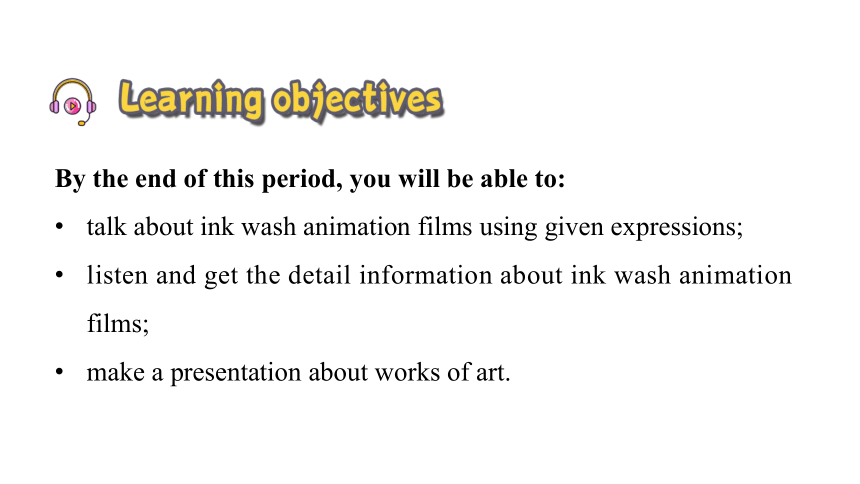
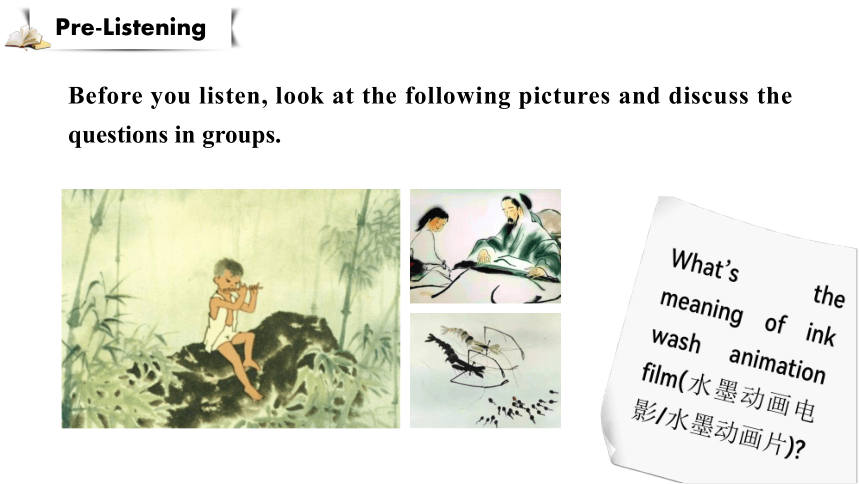
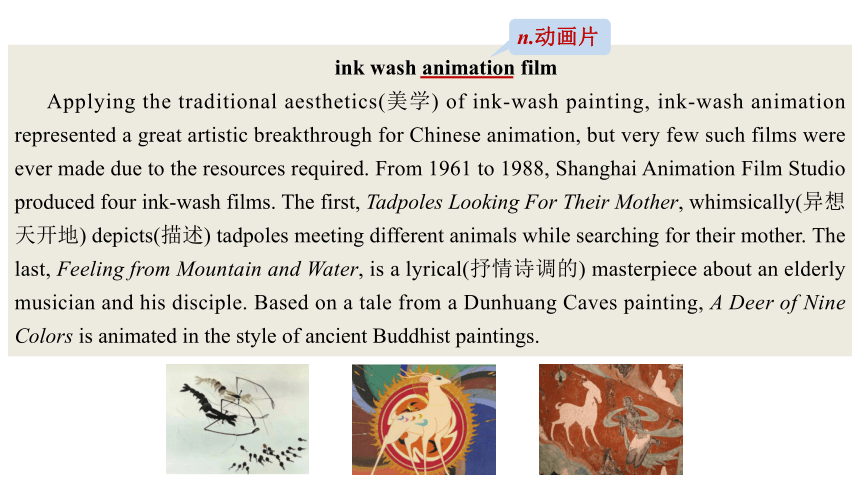
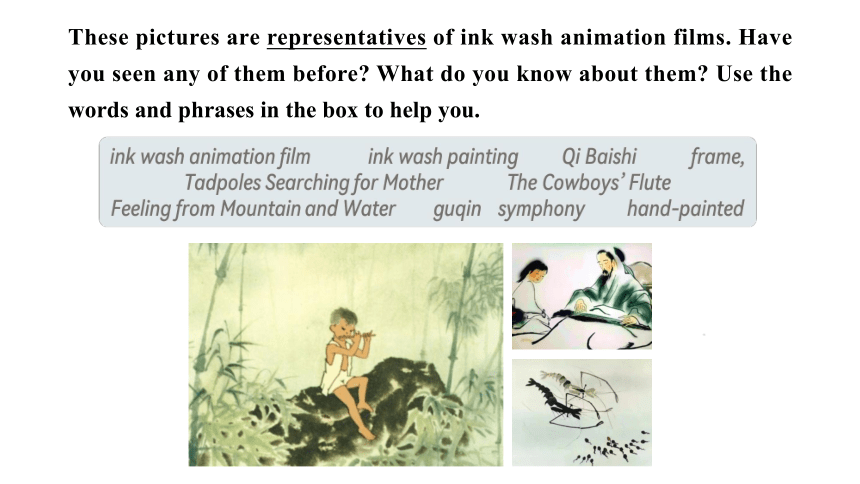
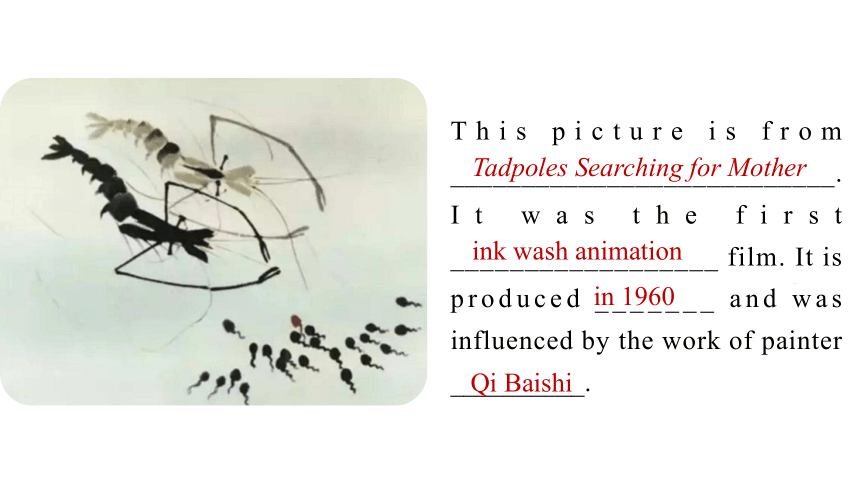
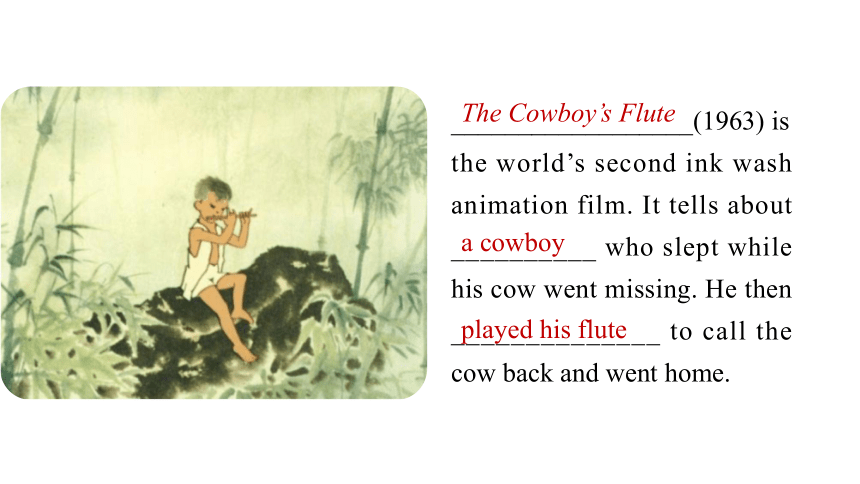
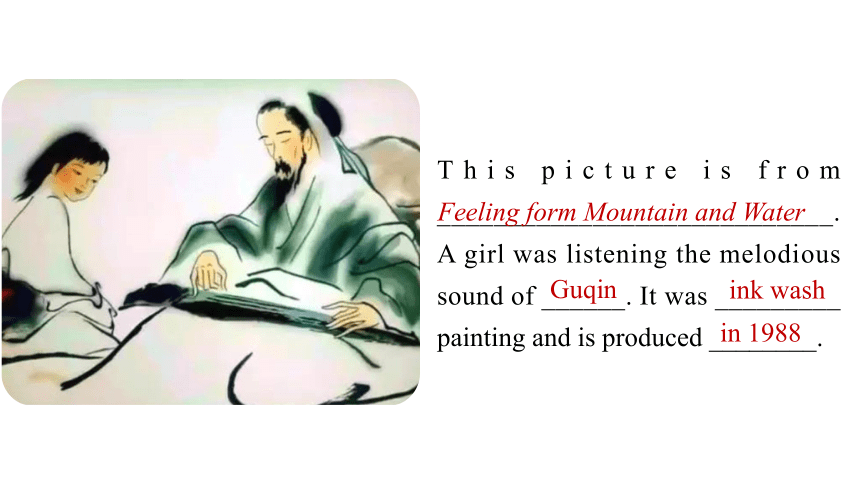
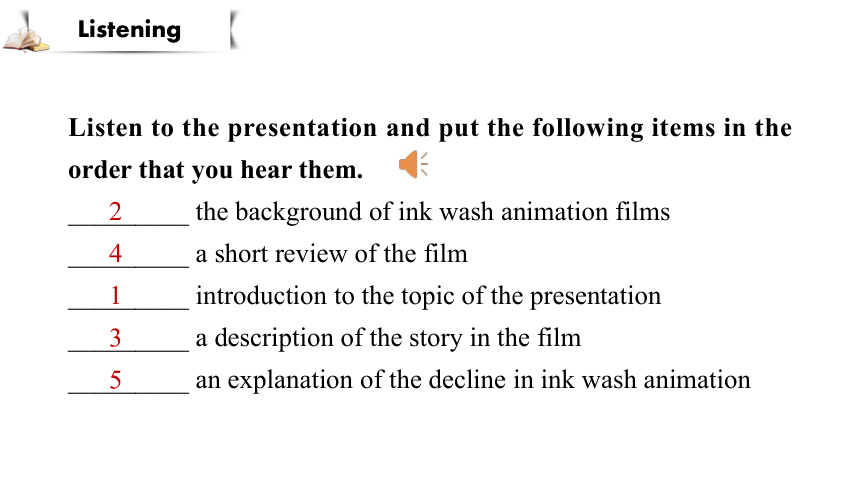
文档简介
(共23张PPT)
Unit 1
Art
Using Language(1)—Listening and Speaking
By the end of this period, you will be able to:
talk about ink wash animation films using given expressions;
listen and get the detail information about ink wash animation films;
make a presentation about works of art.
Pre-Listening
Before you listen, look at the following pictures and discuss the questions in groups.
ink wash animation film
Applying the traditional aesthetics(美学) of ink-wash painting, ink-wash animation represented a great artistic breakthrough for Chinese animation, but very few such films were ever made due to the resources required. From 1961 to 1988, Shanghai Animation Film Studio produced four ink-wash films. The first, Tadpoles Looking For Their Mother, whimsically(异想天开地) depicts(描述) tadpoles meeting different animals while searching for their mother. The last, Feeling from Mountain and Water, is a lyrical(抒情诗调的) masterpiece about an elderly musician and his disciple. Based on a tale from a Dunhuang Caves painting, A Deer of Nine Colors is animated in the style of ancient Buddhist paintings.
n.动画片
These pictures are representatives of ink wash animation films. Have you seen any of them before What do you know about them Use the words and phrases in the box to help you.
This picture is from ___________________________. It was the first __________________ film. It is produced _______ and was influenced by the work of painter __________.
in 1960
ink wash animation
Tadpoles Searching for Mother
Qi Baishi
__________________(1963) is the world’s second ink wash animation film. It tells about __________ who slept while his cow went missing. He then ______________ to call the cow back and went home.
The Cowboy’s Flute
a cowboy
played his flute
This picture is from ____________________________. A girl was listening the melodious sound of ______. It was _________ painting and is produced ________.
in 1988
ink wash
Feeling form Mountain and Water
Guqin
Listening
Listen to the presentation and put the following items in the order that you hear them.
_________ the background of ink wash animation films
_________ a short review of the film
_________ introduction to the topic of the presentation
_________ a description of the story in the film
_________ an explanation of the decline in ink wash animation
2
4
1
3
5
Listen again and answer the questions.
1. Which film does the speaker mainly talk about
Feeling from Mountain and Water.
2. When were the three ink wash animation films produced
They were produced in _______, _______, and _________.
3. Why is the film regarded as a masterpiece of Chinese ink wash animation
Because it is like a fine _________________ brought to life.
4. What is the speaker’s attitude towards the ink wash animation style
The speaker’s attitude towards the style is ________, hoping that new technology will breathe new life into it.
5. How do you feel about this kind of film
I think this kind of film is beautiful and magical to watch. It makes me feel like I am inside a painting.
1960
1963
1988
ink wash painting
positive
Listen again and tick the signpost words that you hear.
Listen for signpost markers
Signpost markers are phrases and expressions that are used to tell a listener what is going to be talked about next. Speakers use signpost markers when they want to introduce a new topic, to start a new point, to give an example, to summarize, etc. By listening for signposts, you will be able to follow what is being said.
Introducing the topic ( )Today, Td like to talk/ speak (to you)about...
( )I’m glad to have this opportunity to...
( )My topic today is...
( )I’d like to share some thoughts on...
starting a point ( )Let me/Let’s start by .....
( )First, let me tell you about...
( )I’ve divided my topic into...parts......
( )Let’s turn now to ...
√
√
√
Giving an example ( )For instance,...
( )For example,...
( )Take...for example,...
( )Let me illustrate...
( )To illustrate,...
( )Let me give you an example,...
Summarising the points ( )In conclusion, .....
( )To conclude,...
( )In short,......
( )To sum up, ...
( )All in all,...
( )In brief,...
√
Listening Text
Today, I’d like to speak to you about the ink wash animated film Feeling from Mountain and Water. Let’s start by talking about the background of ink wash animation, an animation style that is unique to China. This style combines Chinese traditional art with modern animation techniques.
In the late 1950s,inspired by the ink wash painter Qi Baishi, the Shanghai Animation Studio began to explore ways to turn Chinese traditional paintings into cartoon form. The first ink wash animation film, Tadpoles Searching for Mother, was produced in 1960, and it received international praise. Following this, The Cowboy’s Flute was produced in 1963, receiving the golden prize at an international film festival. Finally, in 1988, the ink wash animation masterpiece, Feeling from Mountain and Water was created.
Let’s turn now to the film itself. The film tells the simple story of an old musician and a young boy. In the film, an old musician falls ill while travelling and is helped by a young boy. To thank the boy, the musician teaches him how to play the guqin. With the change of the seasons, it is time for the musician to leave. As the musician says goodbye, he gives the boy his guqin, and then disappears into the mist. Then, when the boy sits down to play the guqin, all of nature joins him in a visual symphony.
The film has no dialogue. And, unlike typical cartoons, the film has no bright colours. In short, it is like a fine ink wash painting which has been brought to life—a painting with movement. The animation and the music make the film not only appealing to the eyes and cars but also rich in emotion. Therefore, this 18-minute film is regarded by many as a masterpiece of Chinese ink wash animation.
After the late 1980s, the high cost of producing ink wash animation caused film studios to stop making them. The techniques used to produce such films simply required too much work, as each frame of the film had to be hand painted. However, in 2016, new artists have begun to make ink wash animated films using computers. It is hoped that these new techniques will breathe new life into this art form.
Work in groups. Choose a work of art you like and prepare information about it.
Introduction Welcome the audience:
Introduce the subject:
Main body Background of the work of art
Description of the work of art
Review of the work of art
Conclusion
Post-Listening
Work in groups. Give a presentation about the work of art.
Introduction
Welcome the audience:
Good morning, everybody. Welcome to my presentation.
Introduce the subject:
I’m very excited to have this opportunity to talk about one of my favorite pieces of art. It is called The Starry Night and was painted by Vincent van Gogh in 1889.
Main body
Background of the work of art:
First, let me tell you about the background of this painting. It shows the French town, Saint-Remy-de-Provence at night. It is based on the view from a window in a hospital where Van Gogh was a patient. Sadly, he suffered from health issues throughout his life, and his work only found fame(获得名气) after his death. Although it shows the view at night, Van Gogh painted it during the day from memory. He also painted other versions at different times of day.
Description of the work of art:
This is an oil painting on canvas(画布). One can immediately tell from its features that it is a Van Gogh painting. For example, the swirls(旋动) in the sky show Van Gogh’s distinctive painting style. The curled dashes of bold color(清晰明显的色彩) can be seen in many of his works. The moon and stars are big and yellow. This was Van Gogh’s favorite color.
Review of the work of art:
Although Van Gogh did not think the painting was very good, it is considered a masterpiece and is one of the most recognized paintings in the history of Western art. It really captures the viewers’ attention and draws them in. It gives the viewer an idea of the state of mind of Van Gogh at this difficult time in his life.
Finish the exercise that is given today.
Homework
Unit 1
Art
Using Language(1)—Listening and Speaking
By the end of this period, you will be able to:
talk about ink wash animation films using given expressions;
listen and get the detail information about ink wash animation films;
make a presentation about works of art.
Pre-Listening
Before you listen, look at the following pictures and discuss the questions in groups.
ink wash animation film
Applying the traditional aesthetics(美学) of ink-wash painting, ink-wash animation represented a great artistic breakthrough for Chinese animation, but very few such films were ever made due to the resources required. From 1961 to 1988, Shanghai Animation Film Studio produced four ink-wash films. The first, Tadpoles Looking For Their Mother, whimsically(异想天开地) depicts(描述) tadpoles meeting different animals while searching for their mother. The last, Feeling from Mountain and Water, is a lyrical(抒情诗调的) masterpiece about an elderly musician and his disciple. Based on a tale from a Dunhuang Caves painting, A Deer of Nine Colors is animated in the style of ancient Buddhist paintings.
n.动画片
These pictures are representatives of ink wash animation films. Have you seen any of them before What do you know about them Use the words and phrases in the box to help you.
This picture is from ___________________________. It was the first __________________ film. It is produced _______ and was influenced by the work of painter __________.
in 1960
ink wash animation
Tadpoles Searching for Mother
Qi Baishi
__________________(1963) is the world’s second ink wash animation film. It tells about __________ who slept while his cow went missing. He then ______________ to call the cow back and went home.
The Cowboy’s Flute
a cowboy
played his flute
This picture is from ____________________________. A girl was listening the melodious sound of ______. It was _________ painting and is produced ________.
in 1988
ink wash
Feeling form Mountain and Water
Guqin
Listening
Listen to the presentation and put the following items in the order that you hear them.
_________ the background of ink wash animation films
_________ a short review of the film
_________ introduction to the topic of the presentation
_________ a description of the story in the film
_________ an explanation of the decline in ink wash animation
2
4
1
3
5
Listen again and answer the questions.
1. Which film does the speaker mainly talk about
Feeling from Mountain and Water.
2. When were the three ink wash animation films produced
They were produced in _______, _______, and _________.
3. Why is the film regarded as a masterpiece of Chinese ink wash animation
Because it is like a fine _________________ brought to life.
4. What is the speaker’s attitude towards the ink wash animation style
The speaker’s attitude towards the style is ________, hoping that new technology will breathe new life into it.
5. How do you feel about this kind of film
I think this kind of film is beautiful and magical to watch. It makes me feel like I am inside a painting.
1960
1963
1988
ink wash painting
positive
Listen again and tick the signpost words that you hear.
Listen for signpost markers
Signpost markers are phrases and expressions that are used to tell a listener what is going to be talked about next. Speakers use signpost markers when they want to introduce a new topic, to start a new point, to give an example, to summarize, etc. By listening for signposts, you will be able to follow what is being said.
Introducing the topic ( )Today, Td like to talk/ speak (to you)about...
( )I’m glad to have this opportunity to...
( )My topic today is...
( )I’d like to share some thoughts on...
starting a point ( )Let me/Let’s start by .....
( )First, let me tell you about...
( )I’ve divided my topic into...parts......
( )Let’s turn now to ...
√
√
√
Giving an example ( )For instance,...
( )For example,...
( )Take...for example,...
( )Let me illustrate...
( )To illustrate,...
( )Let me give you an example,...
Summarising the points ( )In conclusion, .....
( )To conclude,...
( )In short,......
( )To sum up, ...
( )All in all,...
( )In brief,...
√
Listening Text
Today, I’d like to speak to you about the ink wash animated film Feeling from Mountain and Water. Let’s start by talking about the background of ink wash animation, an animation style that is unique to China. This style combines Chinese traditional art with modern animation techniques.
In the late 1950s,inspired by the ink wash painter Qi Baishi, the Shanghai Animation Studio began to explore ways to turn Chinese traditional paintings into cartoon form. The first ink wash animation film, Tadpoles Searching for Mother, was produced in 1960, and it received international praise. Following this, The Cowboy’s Flute was produced in 1963, receiving the golden prize at an international film festival. Finally, in 1988, the ink wash animation masterpiece, Feeling from Mountain and Water was created.
Let’s turn now to the film itself. The film tells the simple story of an old musician and a young boy. In the film, an old musician falls ill while travelling and is helped by a young boy. To thank the boy, the musician teaches him how to play the guqin. With the change of the seasons, it is time for the musician to leave. As the musician says goodbye, he gives the boy his guqin, and then disappears into the mist. Then, when the boy sits down to play the guqin, all of nature joins him in a visual symphony.
The film has no dialogue. And, unlike typical cartoons, the film has no bright colours. In short, it is like a fine ink wash painting which has been brought to life—a painting with movement. The animation and the music make the film not only appealing to the eyes and cars but also rich in emotion. Therefore, this 18-minute film is regarded by many as a masterpiece of Chinese ink wash animation.
After the late 1980s, the high cost of producing ink wash animation caused film studios to stop making them. The techniques used to produce such films simply required too much work, as each frame of the film had to be hand painted. However, in 2016, new artists have begun to make ink wash animated films using computers. It is hoped that these new techniques will breathe new life into this art form.
Work in groups. Choose a work of art you like and prepare information about it.
Introduction Welcome the audience:
Introduce the subject:
Main body Background of the work of art
Description of the work of art
Review of the work of art
Conclusion
Post-Listening
Work in groups. Give a presentation about the work of art.
Introduction
Welcome the audience:
Good morning, everybody. Welcome to my presentation.
Introduce the subject:
I’m very excited to have this opportunity to talk about one of my favorite pieces of art. It is called The Starry Night and was painted by Vincent van Gogh in 1889.
Main body
Background of the work of art:
First, let me tell you about the background of this painting. It shows the French town, Saint-Remy-de-Provence at night. It is based on the view from a window in a hospital where Van Gogh was a patient. Sadly, he suffered from health issues throughout his life, and his work only found fame(获得名气) after his death. Although it shows the view at night, Van Gogh painted it during the day from memory. He also painted other versions at different times of day.
Description of the work of art:
This is an oil painting on canvas(画布). One can immediately tell from its features that it is a Van Gogh painting. For example, the swirls(旋动) in the sky show Van Gogh’s distinctive painting style. The curled dashes of bold color(清晰明显的色彩) can be seen in many of his works. The moon and stars are big and yellow. This was Van Gogh’s favorite color.
Review of the work of art:
Although Van Gogh did not think the painting was very good, it is considered a masterpiece and is one of the most recognized paintings in the history of Western art. It really captures the viewers’ attention and draws them in. It gives the viewer an idea of the state of mind of Van Gogh at this difficult time in his life.
Finish the exercise that is given today.
Homework
